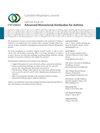在服务不足的纽约社区,群体哮喘教育对哮喘控制和急诊室就诊的影响
IF 2.1
4区 医学
Q3 RESPIRATORY SYSTEM
引用次数: 11
摘要
目的哮喘教育在降低卫生保健服务利用率、改善疾病控制和管理方面具有重要作用。然而,很少有研究评价群体哮喘教育的效果。本研究的目的是评估门诊成人哮喘教育计划在照顾服务不足人群的市中心医院的影响。方法我们对所有哮喘患者进行了一项研究前和研究后的研究,这些患者参加了由呼吸治疗师、临床药师和肺病学家领导的两个结构化的哮喘教育小组。研究期间(2016年1月至2018年4月)包括分组教育前一年和分组教育后一年。主要结果是需要急诊室就诊和住院的患者数量。次要结果包括哮喘控制,通过哮喘控制测试分数评估,使用全身皮质类固醇,以及干预后测试分数的变化。结果88例患者在研究期间接受了分组教育;82人参加2/2次会议,6人参加1/2次会议。研究人群主要为西班牙裔(73%)或非洲裔美国人(25%),平均年龄为58岁。大多数患有中度(57%)或重度(25%)持续性哮喘。值得注意的是,与干预前相比,干预后需要急诊室就诊的患者更少(20例对42例,p=0.0002)。小组教育还与哮喘控制增加(p=0.0043)、全身皮质类固醇使用减少(p=0.0005)和干预后测试分数提高(p=0.0001)相关。结论多学科团队在城市医院门诊为服务不足和少数民族人群提供群体哮喘教育是可行的,当患者接受教育并被授权参与其哮喘管理时,可能会降低卫生保健资源的利用率。本文章由计算机程序翻译,如有差异,请以英文原文为准。
Impact of Group Asthma Education on Asthma Control and Emergency Room Visits in an Underserved New York Community
Objective Asthma education programs have been shown to be effective in decreasing health care utilization and improving disease control and management. However, there are few studies evaluating the outcomes of group asthma education. The aim of this study was to assess the impact of an outpatient adult group asthma education program in an inner-city-based hospital caring for an underserved population. Methods We conducted a pre- and poststudy of all patients with asthma who participated in two structured group asthma education sessions led by a respiratory therapist, clinical pharmacist, and pulmonologist. The study period (January 2016 to April 2018) included the year before group education and the year after education. The primary outcomes were the number of patients requiring emergency room visits and hospital admission. The secondary outcomes included asthma control as assessed by Asthma Control Test scores, use of systemic corticosteroids, and change in test scores postintervention. Results Eighty-eight patients received group education during the study period; 82 attended 2/2 sessions, and 6 attended 1/2 sessions. The study population was largely Hispanic (73%) or African American (25%) and had a mean age of 58 years. Most had moderate (57%) or severe (25%) persistent asthma. Significantly, fewer patients required emergency room visits in the postintervention period than in the preintervention period (20 visits vs. 42 visits, p=0.0002). Group education was also associated with increased asthma control (p=0.0043), decreased use of systemic corticosteroids (p=0.0005), and higher postintervention test scores (p=0.0001). Conclusions Group asthma education provided by a multidisciplinary team in an inner-city hospital clinic caring for underserved and minority populations is feasible and may decrease utilization of health care resources when patients are educated and empowered to participate in their asthma management.
求助全文
通过发布文献求助,成功后即可免费获取论文全文。
去求助
来源期刊

Canadian respiratory journal
医学-呼吸系统
CiteScore
4.20
自引率
0.00%
发文量
61
审稿时长
6-12 weeks
期刊介绍:
Canadian Respiratory Journal is a peer-reviewed, Open Access journal that aims to provide a multidisciplinary forum for research in all areas of respiratory medicine. The journal publishes original research articles, review articles, and clinical studies related to asthma, allergy, COPD, non-invasive ventilation, therapeutic intervention, lung cancer, airway and lung infections, as well as any other respiratory diseases.
 求助内容:
求助内容: 应助结果提醒方式:
应助结果提醒方式:


